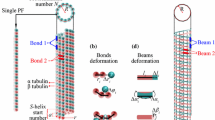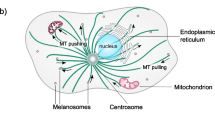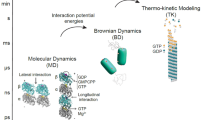Abstract
The aim of this paper was to develop a structural mechanics (SM) model for the microtubules (MTs) in cells. The technique enables one to study the configuration effect on the mechanical properties of MTs and enjoys greatly improved computational efficiency as compared with molecular dynamics simulations. The SM model shows that the Young’s modulus has nearly a constant value around 0.83 GPa, whereas the shear modulus, two orders of magnitude lower, varies considerably with the protofilament number \(N\) and helix-start number \(S\). The dependence of the bending stiffness and persistence length on the MT length and protofilament number \(N\) is also examined and explained based on the continuum mechanics theories. Specifically, the SM model is found to be in good agreement with available simulation and experiment results, showing its robustness in studying the static deformation of MTs and the potential for characterizing the buckling and vibration of MTs as well as the mechanical behaviour of intermediate and actin filaments.






Similar content being viewed by others
References
Alberts B, Johnson A, Lewis J, Raff M, Roberts K, Walter P (2002) Molecular biology of the cell, 4th edn. Garland Science, New York
Brangwynne CP, Koenderink GH, Barry E, Dogic Z, MacKintosh FC, Weitz DA (2007) Bending dynamics of fluctuating biopolymers probed by automated high-resolution filament tracking. Biophys J 93:346–359
Chandran PL, Mofrad MRK (2009) Rods-on-string idealization captures semiflexible filament dynamics. Phys Rev E 79:011906
Chretien D, Wade RH (1991) New data on the microtubule surface lattice. Biol Cell 71:161–174
Chretien D, Fuller SD (2000) Microtubules switch occasionally into unfavorable configurations during elongation. J Mol Biol 298:663–676
Chu JW, Voth GA (2005) Allostery of actin filaments: molecular dynamics simulations and coarse-grained analysis. Proc Natl Acad Sci USA 102:13111–13116
de Pablo PJ, Schaap IAT, MacKintosh FC, Schmidt CF (2003) Deformation and collapse of microtubules on the nanometer scale. Phys Rev Lett 91:098101
Deriu MA, Enemark S, Soncini M, Montevecchi FM, Redaelli A (2007) Tubulin: from atomistic structure to supramolecular mechanical properties. J Mater Sci 42:8864–8872
Deriu MA, Soncini M, Orsi M, Patel M, Essex JW, Montevecchi FM, Redaelli A (2010) Anisotropic elastic network modeling of entire microtubules. Biophys J 99:2190–2199
Donhauser ZJ, Jobs WB, Binka EC (2010) Mechanics of microtubules: effects of protofilament orientation. Biophys J 99:1668–1675
Enemark S, Deriu MA, Soncini M, Redaelli A (2008) Mechanical model of the tubulin dimer based on molecular dynamics simulations. J Biomech Eng 130:041008
Felgner H, Frank R, Schliwa M (1996) Flexural rigidity of microtubules measured with the use of optical tweezers. J Cell Sci 109:509–516
Gao YW, Lei FM (2009) Small scale effects on the mechanical behaviors of protein microtubules based on the nonlocal elasticity theory. Biochem Biophys Res Commun 387:467–471
Gebremichael Y, Chu JW, Voth GA (2008) Intrinsic bending and structural rearrangement of tubulin dimer: molecular dynamics simulations and coarse-grained analysis. Biophys J 95:2487–2499
Gere JM (2003) Mechanics of Materials, 5th edn. Brooks/Cole, Pacific Grove California
Gittes F, Mickey B, Nettleton J, Howard J (1993) Flexural rigidity of microtubules and actin filaments measured from thermal fluctuations in shape. J Cell Biol 120:923–934
Hawkins T, Mirigian M, Yasar MS, Ross JL (2010) Mechanics of microtubules. J Biomech 43:23–30
Hawkins TL, Mirigian M, Li J, Yasar MS, Sackett DL, Sept D, Ross JL (2012) Perturbations in microtubule mechanics from tubulin preparation. Cell Mol Bioeng 5:227–238
Hawkins TL, Sept D, Mogessie B, Straube A, Ross JL (2013) Mechanical properties of doubly stabilized microtubule filaments. Biophys J 104:1517–1528
Howard J (2001) Mechanics of motor proteins and the cytoskeleton. Sunderland, MA
Howard J, Hyman AA (2003) Dynamics and mechanics of the microtubule plus end. Nature 422:753–758
Hunyadi V, Chretien D, Janosi IM (2005) Mechanical stress induced mechanism of microtubule catastrophes. J Mol Biol 348:927–938
Hunyadi V, Chretien D, Flyvbjerg H, Janosi IM (2007) Why is the microtubule lattice helical? Biol Cell 99:117–128
Janosi IM, Chretien D, Flyvbjerg H (1998) Modeling elastic properties of microtubule tips and walls. Eur Biophys J 27:501–513
Janson ME, Dogterom M (2004) A bending mode analysis for growing microtubules: evidence for a velocity-dependent rigidity. Biophys J 87:2723–2736
Ji XY, Feng XQ (2011a) Coarse-grained mechanochemical model for simulating the dynamic behavior of microtubules. Phys Rev E 84:031933
Ji XY, Feng XQ (2011b) Mechanochemical modeling of dynamic microtubule growth involving sheet-to-tube transition. PLoS ONE 6:e29049
Kasas S, Kis A, Riederer BM, Forro L, Dietler G, Catsicas S (2004) Mechanical properties of microtubules explored using the finite elements method. Chem Phys Chem 5:252–257
Kawaguchi K, Yamaguchi A (2010) Temperature dependence rigidity of non-taxol stabilized single microtubules. Biochem Biophys Res Commun 402:66–69
Kikumoto M, Kurachi M, Tosa V, Tashiro H (2006) Flexural rigidity of individual microtubules measured by a buckling force with optical traps. Biophys J 90:1687–1696
Li CY, Chou TW (2003) A structural mechanics approach for the analysis of carbon nanotubes. Int J Solids Struct 40:2487–2499
Li T (2008) Mechanics model of microtubule buckling in living cells. J Biomech 41:1722–1729
Mehrbod M, Mofrad MRK (2011) On the significance of microtubule flexural behavior in cytoskeletal mechanics. PLoS ONE 6:e25627
Mitra A, Sept D (2008) Taxol allosterically alters the dynamics of the tubulin dimer and increases the flexibility of microtubules. Biophys J 95:3252–3258
Mizushima-Sugano J, Maeda T, Miki-Noumura T (1983) Flexural rigidity of singlet microtubules estimated from statistical analysis of their contour lengths and end-to-end distances. Biochim Biophys Acta 755:257–262
Molodtsov MI, Ermakova EA, Shnol EE, Grishchuk EL, McIntosh JR, Ataullakhanov FI (2005) A molecular-mechanical model of the microtubule. Biophys J 88:3167–3179
Pampaloni F, Florin EL (2008) Microtubule architecture: inspiration for novel carbon nanotube-based biomimetic materials. Trends Biotechnol 26:302–310
Pampaloni F, Lattanzi G, Jonas A, Surrey T, Frey E, Florin EL (2006) Thermal fluctuations of grafted microtubules provide evidence of a length-dependent persistence length. Proc Natl Acad Sci USA 103:10248–10253
Schaap IAT, Hoffmann B, Carrasco C, Merkel R, Schmidt CF (2007) Tau protein binding forms a 1 nm thick layer along protofilaments without affecting the radial elasticity of microtubules. J Struct Biol 158:282–292
Sept D, MacKintosh FC (2010) Microtubule elasticity: connecting all-atom simulations with continuum mechanics. Phys Rev Lett 104:018101
Shen HS (2010) Nonlocal shear deformable shell model for postbuckling of axially compressed microtubules embedded in an elastic medium. Biomech Model Mechanobiol 9:345–357
Sirenko YM, Stroscio MA, Kim KM (1996) Elastic vibrations of microtubules in a fluid. Phys Rev E 53:1003–1010
Valdman D, Atzberger PJ, Yu D, Kuei S, Valentine MT (2012) Spectral analysis methods for the robust measurement of the flexural rigidity of biopolymers. Biophys J 102:1144–1153
VanBuren V, Cassimeris L, Odde DJ (2005) Mechanochemical model of microtubule structure and self-assembly kinetics. Biophys J 89:2911–2926
Van Buren V, Odde DJ, Cassimeris L (2002) Estimates of lateral and longitudinal bond energies within the microtubule lattice. Proc Natl Acad Sci USA 99:6035–6040
Van den Heuvel MGL, de Graaff MP, Dekker C (2008) Microtubule curvatures under perpendicular electric forces reveal a low persistence length. Proc Natl Acad Sci USA 105:7941–7946
Venier P, Maggs AC, Carlier MF, Pantaloni D (1994) Analysis of microtubule rigidity using hydrodynamic flow and thermal fluctuations. J Biol Chem 269:13353–13360
Wang CM, Kitipornchai S, Lim CW, Eisenberger M (2008) Beam bending solutions based on nonlocal Timoshenko beam theory. J Eng Mech 134:475–481
Wang CY, Ru CQ, Mioduchowski A (2006a) Vibration of microtubules as orthotropic elastic shells. Physica E 35:48–56
Wang CY, Ru CQ, Mioduchowski A (2006b) Orthotropic elastic shell model for buckling of microtubules. Phys Rev E 74:052901
Wang CY, Li CF, Adhikari S (2009) Dynamic behaviors of microtubules in cytosol. J Biomech 42:1270–1274
Wang CY, Zhang LC (2008) Circumferential vibration of microtubules with long axial wavelength. J Biomech 41:1892–1896
Weaver W Jr, Gere JM (1990) Matrix analysis of framed structures, 3rd edn. Van Nostrand Reinhold, New York
Wu ZH, Nogales E, Xing JH (2012) Comparative studies of microtubule mechanics with two competing models suggest functional roles of alternative tubulin lateral interactions. Biophys J 102:2687–2696
Zhang J, Wang CY, Adhikari S (2013) Molecular structure-dependent deformations in boron nitride nanostructures subject to an electrical field. J Phys D: Appl Phys 46:235303
Acknowledgments
JZ acknowledges the support from the China Scholarship Council (CSC).
Author information
Authors and Affiliations
Corresponding author
Electronic supplementary material
Below is the link to the electronic supplementary material.
Rights and permissions
About this article
Cite this article
Zhang, J., Wang, C. Molecular structural mechanics model for the mechanical properties of microtubules. Biomech Model Mechanobiol 13, 1175–1184 (2014). https://doi.org/10.1007/s10237-014-0564-x
Received:
Accepted:
Published:
Issue Date:
DOI: https://doi.org/10.1007/s10237-014-0564-x




